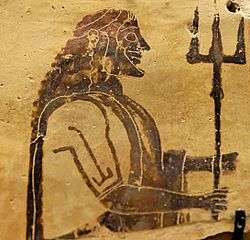Trident of Poseidon

The trident of Poseidon and his Roman equivalent, Neptune, has been their traditional divine attribute featured in many ancient depictions. In Hesiod's account, Poseidon's trident was crafted by the three Cyclopes. According to Robert Graves, however, both the Poseidon's trident and Zeus' thunderbolt were originally a sacred labrys, but later distinguished from each other when Poseidon became god of the sea, while Zeus claimed the right to the thunderbolt.[1] In another view shared by Friedrich Wieseler, E. M. W. Tillyard and several other researchers, Poseidon's trident is a fish spear, typical for coast-dwelling Greeks.[2] In that sense it resembles the arrow-headed pronged fork, used by the Mediterranean fishermen to catch eels. Poseidon became particularly worshipped in coastal countries, where fish formed a basic commodity of trade. According to competing proposal by H. B. Walters, Poseidon's trident is derived from Zeus' lotus sceptre, with Poseidon being Zeus in his marine aspect.[2]
Myths
In Greek myths, Poseidon wields his trident on a number of occasions. During the contest with Athena over the possession of Attica Poseidon strikes the Acropolis with the trident to produce a well of seawater.[3] In a similar myth Poseidon strikes the ground with trident to produce a horse for mankind, while his rival Athena produces an olive tree. The oldest coins of Poseidonia from the 6th century BC depict trident wielded by Poseidon in his right hand, similar to Zeus's thunderbolt. An Attic red figure kylix from c. 475 BC depicts Poseidon killing the Giant Polybotes with his trident.[4] In another myth, Poseidon creates a spring or springs with the strike of his trident to reward Amymone for her encounter with him.[5] In a version of another myth Poseidon wields his trident to scare off a satyr who tries to rape Amymone after she mistakenly hits him with a hunting spear.[5] There is also a myth where Poseidon touches the island of Delos with his trident, affixing it firmly to the sea floor.[6] Another myth tells how Poseidon, enraged by sacrilegious behavior of Ajax the Lesser, splits with trident the rock to which Ajax was clinging. While visiting Athens, geographer Pausanias was shown within the Erechtheion the alleged print of Poseidon's trident on a rock and related sea well which, he writes, gave forth the sound of waves when the south wind blew.[3]
Symbolism
The trident of Neptune was viewed by Roman scholar Maurus Servius Honoratus as three-pronged because "the sea is said to be a third part of the world, or because there are three kinds of water: seas, streams and rivers".[7] According to the second and third Vatican Mythographer, Neptune's trident symbolizes the three properties of water: liquidity, fecundity and drinkability.[7]
Modern references
In present times Poseidon's trident is featured particularly on the flag of Barbados,[8] the coat of arms of Liverpool City Council, the seal of the Greek Navy, the Special Warfare insignia of the U.S. Navy SEALs and the badge of USS John S. McCain. A series of American fleet ballistic missiles Trident is named after Neptune's trident,[9] as well as Operation Neptune Spear. The personification of Great Britain, Britannia is depicted with the trident of Poseidon as a symbol of naval power. The logo of car manufacturer Maserati is based on the trident from the statue of Neptune in Bologna.[10]
The trident of Poseidon is a magical artifact with destructive powers in Michael Livingston's 2015 historical fantasy novel The Shards of Heaven.[11][12]
Notes
- ↑ Robert Graves (2014). "46". The Greek Myths. Anne Books. ISBN 6155530815.
- 1 2 E. C. Quiggin (2012). Essays and Studies Presented to William Ridgeway: On His Sixtieth Birthday - 6th August 1913. Cambridge University Press. pp. 189, 191. ISBN 1107605563.
- 1 2 Jennifer R. March (2014). Dictionary of Classical Mythology. Oxbow Books. p. 115. ISBN 1782976353.
- ↑ Luke Roman, Monica Roman (2010). Encyclopedia of Greek and Roman Mythology. Infobase Publishing. p. 418. ISBN 1438126395.
- 1 2 Robin Hard (2004). The Routledge Handbook of Greek Mythology: Based on H.J. Rose's "Handbook of Greek Mythology". Psychology Press. p. 235. ISBN 0415186366.
- ↑ Trudy Ring, Robert M. Salkin, Sharon La Boda, eds. (1995). International Dictionary of Historic Places: Southern Europe. Taylor & Francis. p. 180. ISBN 1884964028.
- 1 2 H. David Brumble (2013). Classical Myths and Legends in the Middle Ages and Renaissance: A Dictionary of Allegorical Meanings. Routledge. p. 243. ISBN 1136797386.
- ↑ "The Flag of Barbados". Ministry of Foreign Affairs and Foreign Trade of Barbados. Retrieved 6 Aug 2016.
- ↑ "Trident II D-5". Atomic Archive. Retrieved 19 March 2015.
- ↑ "History". Maserati. Retrieved 8 Jan 2016.
- ↑ "The Shards of Heaven by Michael Livingston". Publishers Weekly. Retrieved January 29, 2016.
- ↑ "Review: The Shards of Heaven by Michael Livingston". Kirkus Reviews. September 3, 2015. Retrieved January 29, 2016.